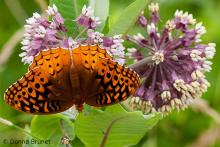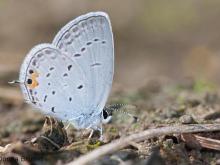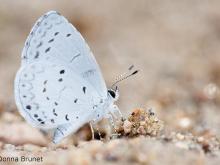Butterflies and Moths
Media

Species Types
Scientific Name
More than 700 species in North America north of Mexico
Description
Learn about butterflies and skippers as a group. What makes a butterfly a butterfly? How are they different from moths? What are the major groups of butterflies?
Media

Species Types
Scientific Name
Speyeria cybele
Description
The great spangled fritillary is common and easily recognized. This glorious butterfly is often seen in city yards and gardens as it seeks flowers.
Media

Species Types
Scientific Name
Lycaena hyllus (syn. Hyllolycaena hyllus; Lycaena thoe)
Description
The bronze copper occurs in localized colonies in throughout northern and western Missouri. Look for it May through October in wet, open, grassy areas.
Media

Species Types
Scientific Name
Cupido comyntas
Description
You can find the eastern tailed-blue in Missouri in prairies, fields, vacant lots, and yards — virtually any open, sunny place.
Media

Species Types
Scientific Name
Celastrina ladon
Description
The spring azure is among the first butterflies of the year. It occurs in a variety of habitats. The early spring appearance helps you identify it.
Media

Species Types
Scientific Name
Celastrina neglecta
Description
Formerly considered the same species as the spring azure, the summer azure can be identified, in large part, by the season when you see it.
Media

Species Types
Scientific Name
Calephelis muticum
Description
The swamp metalmark is one of only two metalmark butterflies found in Missouri; both are rare, occurring only in small, localized colonies, mostly in the southern half of the state. This species lives in low, damp or wet areas, and its favorite food plant is swamp thistle.
See Also


Media

Species Types
Scientific Name
About 1,500 species in North America north of Mexico
Description
Adult caddisflies are mothlike. Their larvae are aquatic and build portable, protective cases out of local materials, including grains of sand, bits of leaves and twigs, and other debris.
Media

Species Types
Scientific Name
Corydalus cornutus
Description
Adult eastern dobsonflies are huge and mothlike, with large wings and a weak, fluttery flight. The fiercely predaceous aquatic larvae, called hellgrammites, are well-known to anglers, who often use them as bait.
About Butterflies and Moths in Missouri
Butterflies, skippers, and moths belong to an insect order called the Lepidoptera — the "scale-winged" insects. These living jewels have tiny, overlapping scales that cover their wings like shingles. The scales, whether muted or colorful, seem dusty if they rub off on your fingers. Many butterflies and moths are associated with particular types of food plants, which their caterpillars must eat in order to survive.





















